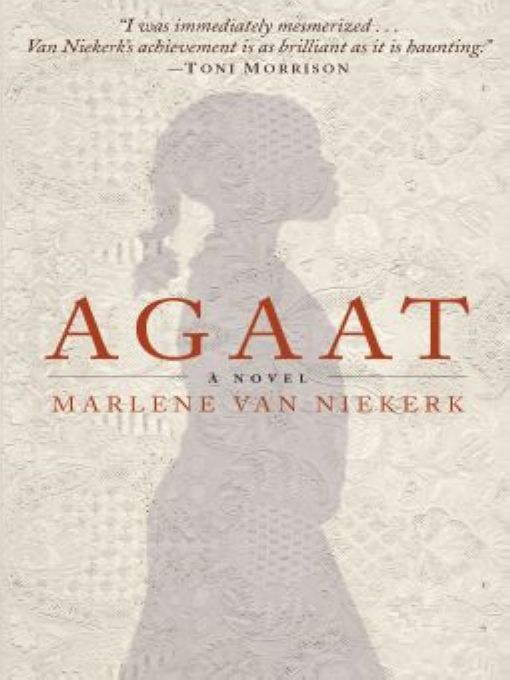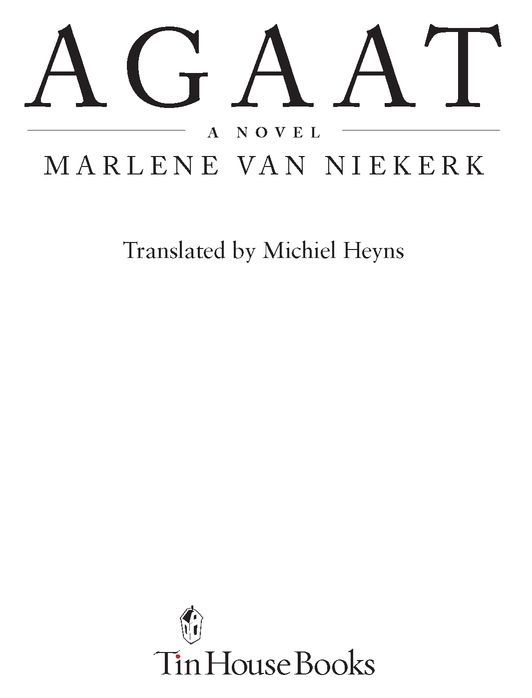Agaat
Authors: Marlene van Niekerk


Table of Contents
Â
Â
Â
Â
Â
Â
Â
Â
Â
Â
Â
Â
Â
Â
Â
Â
Â
Â
Â
Â
Â
Â
Also by Marlene van Niekerk
Triomf

For Lou-Marié
TRANSLATOR'S NOTE
Agaat
is a highly allusive text, permeated, at times almost subliminally, with traces of Afrikaans cultural goods: songs, children's rhymes, children's games, hymns, idiomatic expressions, farming lore. I have as far as possible made my own translations of these, in an attempt to retain something of the sound, rhythm, register and cultural specificity of the original. Where, however, the author has quoted from mainstream Afrikaans poetry, I have tried to find equivalents from English poetry. I have also taken the liberty of extending the range of poetic allusion. Readers will thus find scraps of English poetry interspersed, generally without acknowledgement, in the text.
is a highly allusive text, permeated, at times almost subliminally, with traces of Afrikaans cultural goods: songs, children's rhymes, children's games, hymns, idiomatic expressions, farming lore. I have as far as possible made my own translations of these, in an attempt to retain something of the sound, rhythm, register and cultural specificity of the original. Where, however, the author has quoted from mainstream Afrikaans poetry, I have tried to find equivalents from English poetry. I have also taken the liberty of extending the range of poetic allusion. Readers will thus find scraps of English poetry interspersed, generally without acknowledgement, in the text.
Certain Afrikaans words I have judged too culturally specific to be translated into English; indeed, almost all the Afrikaans words I have used in this translation occur either in the
Oxford English Dictionary
or the
Oxford Dictionary of South African English
, as having passed into South African English usage. For readers not having ready access to these sources, a glossary of Afrikaans words is appended.
Oxford English Dictionary
or the
Oxford Dictionary of South African English
, as having passed into South African English usage. For readers not having ready access to these sources, a glossary of Afrikaans words is appended.
I am grateful to Lynda Gilfillan for her meticulous editing of this translation, and to Riana Barnard for her efficient and cheerful administration.
âM.H.
âThis new volume seeks to interpret the growth, passion and expansion of the soul of the nation. May the indefinable elementâthe force and flavour of this Southlandâbe found, felt and experienced, then the nation will press it to their hearts and adopt it as their own.'
From the Introduction to the first edition of the
FAK-Volksangbundel
[National Anthology of Song of the Federation of Afrikaans Culture Organisations]. H. Gutsche, W.J. du P. Erlank, S.H. Eyssen (eds.). Firma J.H. De Bussy Pretoria, HAUM. V/H Jacques Dusseau & Co, Cape Town, 1937.
FAK-Volksangbundel
[National Anthology of Song of the Federation of Afrikaans Culture Organisations]. H. Gutsche, W.J. du P. Erlank, S.H. Eyssen (eds.). Firma J.H. De Bussy Pretoria, HAUM. V/H Jacques Dusseau & Co, Cape Town, 1937.
âThat is the beauty, the value of this book: that it was born out of love and inspires to love, that nobody can doubt. And with that a great service is done to the nation, for who feels for beauty, on whatever terrain, has a contribution to make to the cultural development of the nation.
âThe area this book makes its own, is a specifically feminine one and through that contributes to the refinement and beautification of the domestic atmosphere. Such an atmosphere distinguishes the culturally aware nation from the uncivilised.'
From the Foreword by Mrs E. (Betsie) Verwoerd to
Borduur So
[Embroider Like This], Hetsie van Wyk, Afrikaanse Pers-boekhandel, Johannesburg, 1966.
Borduur So
[Embroider Like This], Hetsie van Wyk, Afrikaanse Pers-boekhandel, Johannesburg, 1966.
âThis Handbook . . . serves as a key to the unlocking of the treasure chambers of climate, soil, livestock and marketing potential on each of the 93,000 farms of our country.
âJust as the Bible points the way to spiritual perfection so will this Handbook also point to ways and means to more profitable farming and to greater prosperity for every farmer in every part of the country.
Other books
A Scandalous Scot by Karen Ranney
The Lost Tycoon by Melody Anne
The Ink Bridge by Neil Grant
Bath Belles by Joan Smith
The Zone by RW Krpoun
The White Spell by Lynn Kurland
The Spider's Web by Coel, Margaret
La imperfección del amor by Milena Agus
The Bone Box by Gregg Olsen
Elaine Orr - Jolie Gentil 07 - Vague Images by Elaine Orr
